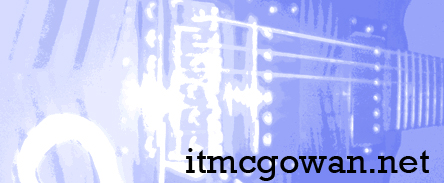
Modes
Don't let it confuse you, it is not as complicated as may seem.
Modes are the derivation of modern music's diatonic scales, they are a way of interpreting and playing a scale. Modes
are a useful improvisation tool.
Yeah, so what does that mean?
It means that we can improvise several scales over the same set of chords.
Lets start at CMajor because it is easy and saves me writing sharps and flats.
So
C or CMajor is our C Ionian mode
If we play the same notes of the CMajor scale, the Ionian, but start at the second degree, that is D, E, F, G, A, B, C, D we have played the D Dorian mode.
Continuing in a logical way as the table below shows will bring us to A Aeolian scale also known as the Relative minor.
In other words A Aeolian sounds right against the chords that belong to the C Ionian OR PUT ANOTHER WAY
Aminor scale sounds right against the chords that belong to the CMajor and it should for they are the same notes
just played in another order.
You may well ask why should it sound different if it is the same notes?
Well it is because the intervals fall in different places. If you consider cadences this is very important. Simply put a
cadence is the musical equivalent of a full stop. If you sing "Amen" you have sung a cadence, a cadence sounds
complete and finished, no more needed. A half cadence is like a comma. There is more music to come, but not much...
Whether this helps you improvise is entirely up to you. I have had other players comment I use modes when playing lead. Well I am but only "in-the-back" of my mind really I am trying to sing using my guitar.
Finding your own lead whether melodic or harmonic is always a great thrill, a little bit sweeter than copying note-for-note or by rote another's lead.
The mind should know the way but the soul should show the way.
In other words, have an idea which notes or scales
may
work over a set of chords as a starting point for your lead and
then try and improvise the notes from thoae notes and try to add some that don't belong, the blue notes.
Think in horn lines like Louis Armstrong and don't forget to leave spaces for breath or you end up with too much.
Some times less is more but some times more is more.
|
|
Modes |
|
||||
1 |
C | Ionian |
|
|
C |
to |
C |
2 |
D | Dorian |
|
|
D |
to |
D |
3 |
E | Phrygian |
|
|
E |
to |
E |
4 |
F | Lydian |
|
|
F |
to |
F |
5 |
G | Mixolydian |
|
|
G |
to |
G |
6 |
A | Aeolian |
|
|
A |
to |
A |
7 |
B | Locrian |
|
|
B |
to |
B |